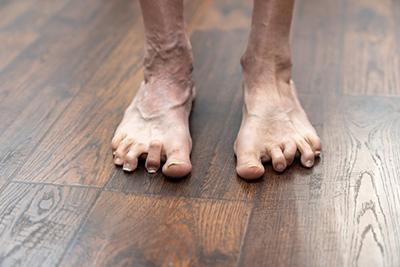
Hammer toes refer to a common foot irregularity. According to Michael K. Block, DPM, with locations that serve Abingdon and Bel Air, MD, hammer toes happen when the middle joint of one (or more than one) of your small toes becomes irregularly shaped and even starts to look like a hammer.
The Causes of Hammer Toes
A hammer toe can develop due to various factors that, when chronic or intense, cause a foot imbalance that affects the soft tissue that keeps your toe in straight alignment - tendons, ligaments, and muscles. Most people recognize that age plays a prominent role; however, certain medical conditions (i.e., neuropathy) and genetics (i.e., weaker muscles) may have some influence on hammer toe development.
- Improper Footwear Can Impact Hammer Toe Development.
Wearing shoes that do not fit properly, put your foot in an unnatural position, or shoes that are too narrow or tight can contribute to hammer toe development over time. - Foot Structure Has Some Impact.
People with high-arched feet or a second toe longer than the big toe are at higher risk of developing a hammer toe. - An Injury Can Cause a Hammer Toe to Develop.
Stubbing a toe can cause muscle imbalances that increase your risk of hammer toe formation.
Hammer Toe Podiatric Treatments
The most appropriate hammer toe treatment options will depend on the patient’s -
- Condition.
- Overall health.
- Pain tolerance.
- Level of activity level and more.
Non-Surgical Treatments
The most obvious guidance is choosing proper-fitting, low-heeled shoes – or those designed with a roomy toe box. Additionally, consider the following -
Orthotic Inserts
Orthotics can enhance your foot’s alignment, reducing pain and pressure. Shoe inserts are available generically as OTC options or customized through a podiatrist’s prescription.
Medications
Nonsteroidal anti-inflammatory drugs can help with pain/swelling related to hammer toes.
Toe/Therapeutic Exercises
Toe exercises can impede the hammer toe’s progression as it helps to strengthen and stretch toe muscles.
Splinting/Padding and Taping
Padding or tape can effectively reduce friction and, therefore, pain and inflammation.
Corticosteroid Injections
These help reduce inflammation and pain in the toe joints, providing relief from painful hammer toe symptoms.
Surgical Intervention
If conservative options fail to provide sufficient relief, surgery may be an option.
Consult a Leading Abingdon and Bel Air, MD, Podiatrist Today
Early intervention is essential in helping to prevent or slow hammer toe progression. If you suspect you have hammer toes or have any type of foot pain, contact Michael K. Block, DPM, or a staff member at (410) 569-0445 or online.
